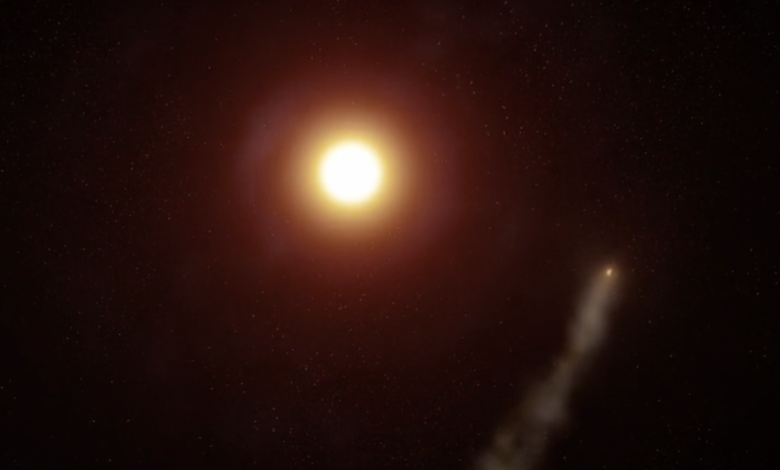Scientists find planet with a tail 150 times longer than the Mississippi

It’s not just comets that have extremely long tails.

A conception of exoplanet WASP-69b, with a long tail, orbiting its star.
Credit: W. M. Keck Observatory / Adam Makarenko
There are some strange planets out in deep space.
Now, scientists have found a planet with a tail at least 350,000 miles (563,270 kilometers) long. That’s longer than the distance between Earth and the moon, and about 150 times longer than the Mississippi River. Helium gas is escaping from the Jupiter-sized planet WASP-69b, located 160 light-years away from Earth. With observations from the giant W. M. Keck Observatory atop Hawaii, researchers detected this planetary leak has created an expansive tail.
“Previous observations suggested that WASP-69b had a modest tail, or no tail at all,” Dakotah Tyler, an astrophysics doctoral candidate at UCLA and first author of the research, said in a statement. “However, we have been able to definitively show that this planet’s helium tail extends at least seven times the radius of the giant planet itself.”
The new research about this curious exoplanet — a planet orbiting another star — was recently published in the The Astrophysical Journal.
Mashable Light Speed
WASP-69b orbits extremely close to its star, making an orbit in just 3.9 days. The scorching nearby heat burns off the planet’s atmosphere. You can see a conception of this happening in the short video below, posted to X (formerly Twitter).
The expansive mirror of the observatory’s Keck II telescope — 30 meters wide (nearly 100 feet) — allowed the researchers to catch enough light to see the planet’s distant tail. “What truly set Keck apart in our observations was the large collecting area of its mirror, which enabled us to detect far more light from the star,” Tyler explained. Another instrument attached to the telescope, called the Near-Infrared Spectrograph (NIRSPEC), captured high-resolution details about the wispy tail.
Scientists estimate that WASP-69b loses the mass of Earth in gas every billion years or so. (Fortunately, the planet is 90 times more massive than Earth, so it has a lot to lose.)
NASA has already identified over 5,560 exoplanets, with over 10,000 more planetary candidates under review. What else will astronomers find out there?

Mark is an award-winning journalist and the science editor at Mashable. After communicating science as a ranger with the National Park Service, he began a reporting career after seeing the extraordinary value in educating the public about the happenings in earth sciences, space, biodiversity, health, and beyond.
You can reach Mark at [email protected].
This newsletter may contain advertising, deals, or affiliate links. Subscribing to a newsletter indicates your consent to our Terms of Use and Privacy Policy. You may unsubscribe from the newsletters at any time.


